Click on images to enlarge
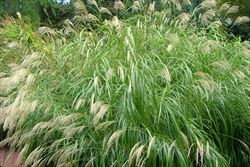
habit (Photo: Sheldon Navie)
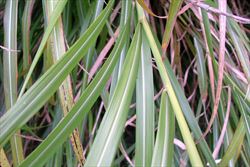
leaves (Photo: Sheldon Navie)
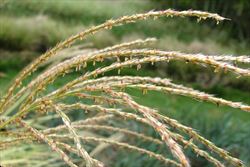
young seed-head in flower (Photo: Sheldon Navie)
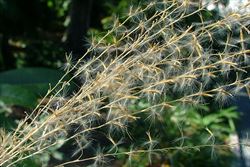
close-up of mature seed-head (Photo: Sheldon Navie)
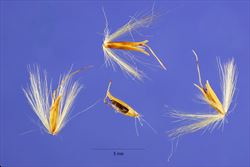
close-up of seeds (Photo: Steve Hurst at USDA PLANTS Database)
Scientific Name
Miscanthus sinensis Andersson
Family
Gramineae (South Australia)Poaceae (Queensland, New South Wales, the ACT, Victoria, Tasmania, Western Australia and the Northern Territory)
Common Names
Chinese fairy grass, Chinese grass, Chinese silver grass, Chinese silvergrass, eulalia, eulalia grass, fairy grass, Japanese silver grass, Japanese silvergrass, maiden grass, miscanthus, plume grass, striped fountain grass, susuki grass
Origin
Native to eastern Asia (i.e. eastern Russia, eastern China, Japan, Korea, Taiwan, Indonesia and the Philippines).
Naturalised Distribution
Naturalised in some temperate regions in southern Australia (i.e. the coastal and sub-coastal districts of central New South Wales, in south-eastern South Australia and near Perth in south-western Western Australia).
Also naturalised overseas in Chile and the USA.
Notes
Miscanthus (Miscanthus sinensis) is regarded as an environmental weed in New South Wales and as a potential environmental weed in Victoria. It is also listed as a priority environmental weed in at least one Natural Resource Management region. This ornamental grass, which has become common in cultivation in recent years, has become a weed of roadsides, railway embankments, disturbed sites, forest margins and urban bushland. Miscanthus (Miscanthus sinensis) forms large and dense tussocks of vegetation and extensive infestations can prevent the growth and germination of native plants. It rapidly colonises disturbed or open areas, and can invade large areas of bushland following fires.
Miscanthus (Miscanthus sinensis) is of most concern in the Blue Mountains on the New South Wales Central Tablelands. It is currently mainly naturalised in the mid to upper Blue Mountains, but is thought to have the potential to colonise areas throughout this region. This species is also potentially very invasive in Victoria, and is included in the list of "weed alert" species in this state.
In the USA, where miscanthus (Miscanthus sinensis) is widely naturalised, its ability to inhabit disturbed areas and its popularity as an ornamental species make it a potentially serious threat to native flora. In its native Japan, miscanthus (Miscanthus sinensis) readily colonises abandoned fields, preventing the regeneration of oak forests. It is also listed in the Global Invasive Species Database.
Note: As well as numerous modern cultivars, there are three common forms of this species present in cultivation in Australia. Depending on the location, these are sometimes regarded as separate varieties or older cultivars:
- miscanthus (Miscanthus sinensis var. sinensis or Miscanthus sinensis) has entirely green leaves.
- variegated miscanthus (Miscanthus sinensis var. variegatus or Miscanthus sinensis 'Variegatus') has leaves with whitish stripes running lengthwise (i.e. londitudinally).
- zebra grass (Miscanthus sinensis var. zebrinus or Miscanthus sinensis 'Zebrinus') has leaves with whitish stripes running crossways (i.e. transversely).

